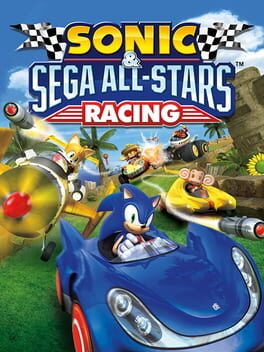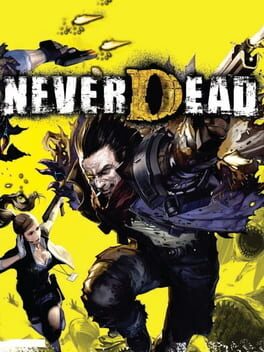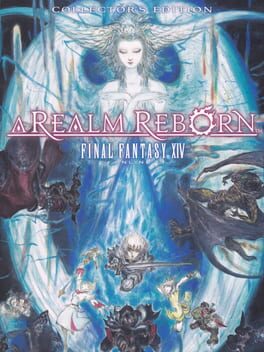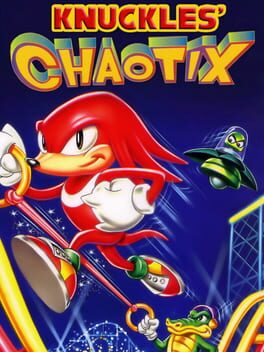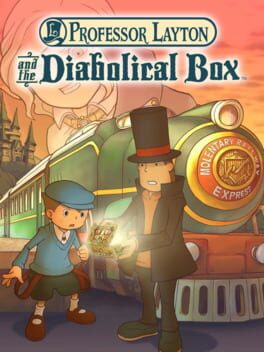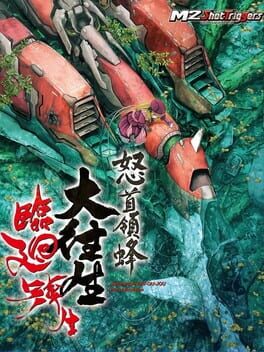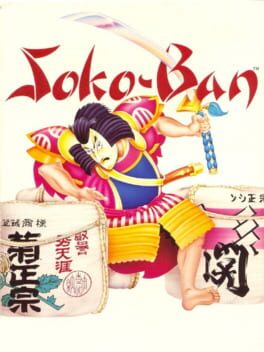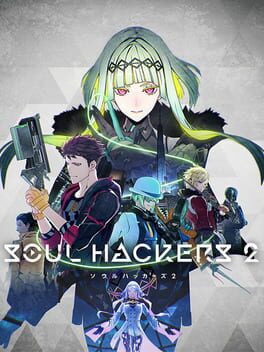EphemeralEnigmas
18 reviews liked by EphemeralEnigmas
This is an alright game. The lack of budget is noticeable (there's only about 6 different possible themes for each course, which means some racetracks look nearly identical to one another. This allows for heavy amounts of asset reuse), and I find it a bit weird that most characters you need to spend in-game currency to unlock. But it's actually pretty fun to race in - this game really emphasizes drifting and getting extra speed boosts in the process. I had a good time with the core gameplay, but this leaves a bit to be desired.
NeverDead
2012
I really don't know where to start with this game. Gathering my thoughts on NeverDead is a difficult one... I think what it comes down to, when all is said and done, is that NeverDead has some interesting ideas, and it's willing to experiment with bold new things (primarily, a protagonist who cannot die - and said immortality is reflected in the gameplay itself)... but the execution does leave a lot to be desired. The combat is, perhaps serviceable - generally melee combat is going to be far more effective, so your guns feel like an afterthought. But after most types of damage that the protagonist Bryce takes, he literally falls to pieces, like Humpty Dumpty, and then as a severed head, you need to slowly roll around and gather up your limbs and torso to reattach yourself, so you can go back to peak fighting shape again.
It's weird... when you're not falling apart, it can be enjoyably silly, but when you fall apart, it suddenly becomes extremely irritating. It's like the punishment you get from taking damage in say, The Legend of the Mystical Ninja (where getting hurt causes you to lose both attack power/range, and movement speed), but amplified by a thousand. Gosh this is an infuriating game a lot of the time - I'm not surprised most people hate it.
Is it worth trying? Maybe? That'll depend on how much you can tolerate occasional bullshit being tossed your way.
It's weird... when you're not falling apart, it can be enjoyably silly, but when you fall apart, it suddenly becomes extremely irritating. It's like the punishment you get from taking damage in say, The Legend of the Mystical Ninja (where getting hurt causes you to lose both attack power/range, and movement speed), but amplified by a thousand. Gosh this is an infuriating game a lot of the time - I'm not surprised most people hate it.
Is it worth trying? Maybe? That'll depend on how much you can tolerate occasional bullshit being tossed your way.
not even done yet but jesus christ this is so miserable, i am literally only able to do the droll sidequesting msq content by turning my brain off for an hour or two at a time and skipping every line of dialog because if i invest any more thought than that into this game i feel like i might never want to play another video game in my life. it is insane how dragon quest 10's first version bodies everything arr sets out to do effortlessly when it came out a year earlier and also wasn't a second draft like a realm reborn is. if ff14 ends up being something like xenoblade 2 where it doesn't even get nearly good enough to make up for how much time you waste to get to the "good" part i am so sincerely never playing a game on suggestion of my friends again.
my au ra is cute at least though
my au ra is cute at least though
Hollow Knight
2017
I finally finished this one after putting a few hours into it a couple years back. It's an extremely well-crafted side-scrolling Dark Souls that everyone thinks is a Metroidvania.
The combat is excellent and a high point of the game. Later boss encounters in particular are some of the most satisfying times I've had with an action game in a while. Traversal is equally enjoyable after unlocking a few abilities and wonderfully fluid in the final quarter or so once you pick up the last big ones.
A few things brought this one down for me a little below where a lot of other folks place it. While the art style and aesthetics did frequently win me over, too much of the game is draped in drab color palettes and minimal musical accompaniment. Even more unfortunately, the duller areas in the game are mostly grouped towards the beginning, which is an interminable slog that put me off the game until I finally built up the willpower to break through. But I'm glad I finally did, because the back half has some fantastic bits.
I didn't do the vast majority of the optional content. It's possible that I might revisit it at some point and revise my rating if there's a lot of worthwhile stuff there. As things currently stand, it's a pretty dang good game, but I'm having a lot of trouble understanding why anyone would put this above SotN.
The combat is excellent and a high point of the game. Later boss encounters in particular are some of the most satisfying times I've had with an action game in a while. Traversal is equally enjoyable after unlocking a few abilities and wonderfully fluid in the final quarter or so once you pick up the last big ones.
A few things brought this one down for me a little below where a lot of other folks place it. While the art style and aesthetics did frequently win me over, too much of the game is draped in drab color palettes and minimal musical accompaniment. Even more unfortunately, the duller areas in the game are mostly grouped towards the beginning, which is an interminable slog that put me off the game until I finally built up the willpower to break through. But I'm glad I finally did, because the back half has some fantastic bits.
I didn't do the vast majority of the optional content. It's possible that I might revisit it at some point and revise my rating if there's a lot of worthwhile stuff there. As things currently stand, it's a pretty dang good game, but I'm having a lot of trouble understanding why anyone would put this above SotN.
At once one of the worst and best games I've played in a while. I'm compelled enough to want to know what they're doing, but also the act of trying to figure out what they're doing is a fool's errand. Rebirth is exceptional when it's about hanging out. But it's weighed down so heavily by the worst case of ubisoft open world bloat I've ever put up with. Its combat system could be studied in universities for eons, it's obscenely, disgustingly, putridly brilliant. Boss fights in this game are some of the most fun and fascinating collaborations of systems and creative design I can recall, and I don't think they're getting nearly enough credit for just how intricate it is. But 95% of the fighting in this game is generic fodder enemies that turn it into a borderline-musou level of turn-off-brain-and-mash-square. The bulk of this game does disservice to everything it excels at. It bogs itself down with frivolous padding at every opportunity—every little action takes like a second and a half longer than you'd expect, making it feel sloppy and unresponsive in the hands when outside of combat, which is most of the time. The composition work on this score is some inconceivable galaxy brain stuff. We're talking minimum 200 IQ moves all over the place. I cannot wait for that big-ass CD box set, dude. That's my main takeaway from this game.
Knuckles' Chaotix
1995
What a deeply weird game. I get what they're going for and I can also tell the team was struggling to make it all work. I feel like the heavy momentum-based swinging mechanics could be made to work even if this game isn't quite there. The level design feels like they were flailing, and like development cut off before they actually figured out how to build levels that play well with this movement.
Killer aesthetics and secretly one of the best Sonic soundtracks.
Killer aesthetics and secretly one of the best Sonic soundtracks.
better sense of scale than the first regarding both its central mystery and its locales. for one, you're given much more room to stretch your legs, with the second half of the game taking place in an area roughly the size of the entire first game and the first half having a few beefy areas of its own. the multiple mysteries in this one indeed also expand beyond the big endgame twist, and more care has been taken to drop breadcrumbs of intrigue throughout the adventure rather than the meandering approach of curious village. at the same time, the larger cast of characters and tragic lover's bond at the heart of the narrative makes the lack of attention paid to their actual characterization more noticeable. an examination of the folly of a rich family mining the earth and bringing ruin on their workers becomes didactic quickly when it's conveyed entirely through history lessons and layton's personal observations, and the writers' preoccupation with preserving the shock of the primary mystery keeps the actual humans at the core of the conflict from expressing themselves until the final ten minutes. I've cooled off on curious village's twist in the couple of years since I played it, and even though this one is probably more interesting, it still feels like a sudden burst of passion at the end of another meandering 15 hour adventure. then again, more pretty backgrounds than last time, so it all comes out in the wash.
puzzles in general are now better integrated into the story; layton still lives in an alternate reality where everyone is obsessed with puzzles, but at least he's actually using his skill at solving them in practical ways to navigate the world and solve mysteries. I'll hesitatingly say that conceptual puzzles seem to be fewer in number compared to curious village, with more focus on various physical layout puzzles and some math ones here and there. conceptual puzzles have the strength of obfuscating a solution space and thus making the exercise feel more like a product of reasoning and less trial and error, but I do also appreciate the variety of layout puzzles here, especially when it comes to ones like chopping wood in the right place to make a square or placing lanterns to cover every path of a forest. tired of maze puzzles tho; really no mental leaps required for them beyond just following each path to the right place. those are really the other extreme compared to conceptual puzzles, where the whole solution space is there for you to look at and you just check off whatever path leads to the finish. the best conceptual puzzles come on the critical path at least, so you won't miss any of them.
there's also better scaffolding around the ADV parts of the experience to keep exploration fresh thanks to some new integrated minigames. there's a persistent puzzle with an exercising hamster you must lead around a grid in order to have him reach a step count, and by solving puzzles around the world you can win items with new properties for him to chase. the puzzle itself is cool, and having a variety of ways to reach the maximum step count goes a long way to making the puzzle feel less prescriptive. when that's reached, he'll pop up in the world to tell you where you can find hint coins, removing the pixel hunting component of the game completely. there's camera components you can find as well that, once assembled, can be used to take pictures of specific rooms in the game. this opens up a "find the differences" type game that will open up a bonus puzzle; another neat addition that complements the main draw nicely. the third is less interesting: you can win different tea ingredients to make people tea? in-game there's no benefit to doing this, although I have a feeling some of the post-game puzzles will unlock if you can serve all the different kinds of tea. problem is figuring out all of the different brews is complete trial-and-error, and although some NPCs will give you recipes, others are much more vague. would help if some NPCs who want tea didn't suddenly stop wanting tea if you fuck up their initial order, though considering that they randomly re-enable later I have a feeling this is just some scripting issue.
puzzles in general are now better integrated into the story; layton still lives in an alternate reality where everyone is obsessed with puzzles, but at least he's actually using his skill at solving them in practical ways to navigate the world and solve mysteries. I'll hesitatingly say that conceptual puzzles seem to be fewer in number compared to curious village, with more focus on various physical layout puzzles and some math ones here and there. conceptual puzzles have the strength of obfuscating a solution space and thus making the exercise feel more like a product of reasoning and less trial and error, but I do also appreciate the variety of layout puzzles here, especially when it comes to ones like chopping wood in the right place to make a square or placing lanterns to cover every path of a forest. tired of maze puzzles tho; really no mental leaps required for them beyond just following each path to the right place. those are really the other extreme compared to conceptual puzzles, where the whole solution space is there for you to look at and you just check off whatever path leads to the finish. the best conceptual puzzles come on the critical path at least, so you won't miss any of them.
there's also better scaffolding around the ADV parts of the experience to keep exploration fresh thanks to some new integrated minigames. there's a persistent puzzle with an exercising hamster you must lead around a grid in order to have him reach a step count, and by solving puzzles around the world you can win items with new properties for him to chase. the puzzle itself is cool, and having a variety of ways to reach the maximum step count goes a long way to making the puzzle feel less prescriptive. when that's reached, he'll pop up in the world to tell you where you can find hint coins, removing the pixel hunting component of the game completely. there's camera components you can find as well that, once assembled, can be used to take pictures of specific rooms in the game. this opens up a "find the differences" type game that will open up a bonus puzzle; another neat addition that complements the main draw nicely. the third is less interesting: you can win different tea ingredients to make people tea? in-game there's no benefit to doing this, although I have a feeling some of the post-game puzzles will unlock if you can serve all the different kinds of tea. problem is figuring out all of the different brews is complete trial-and-error, and although some NPCs will give you recipes, others are much more vague. would help if some NPCs who want tea didn't suddenly stop wanting tea if you fuck up their initial order, though considering that they randomly re-enable later I have a feeling this is just some scripting issue.
If you know the original game, or if you know M2, you don't really need to ask "is the game good" or "is the port good" - you know the game's good, and you know the port will be great.
Dai-Ou-Jou is one of those games shmup people talk about a lot, but for good reason - it's a genuine classic, and it's still just as good today. The core, elemental mechanics - a laser that slices through enemies and slows you down for precision dodging, a shot that lets you move fast while taking out small enemies - are common to a lot of shmups, but they're executed flawlessly here. Its signature mechanic, the hyper attack, is still just as satisfying. Playing well enough to earn the hyper lets you turn the tables to do incredible damage to enemies, taking out waves or bosses that feel impossible otherwise; the feeling of power after being under pressure feels great.
The new arrange pilots are great, and a lot of fun. I wasn't sure what to expect, but they change up the core gameplay in very interesting ways. They're also all easier than the core game, but they use the original game's enemy placement and bullet patterns; learning the arrange pilots is still learning the "real" arcade game. It's a fantastic bridge for intermediate players who want something more substantial than super easy mode, not to mention something I enjoy playing when I want to actually see more than 1-2 levels in a run. I'm not good enough to master the original arcade game yet, much as I'm working on it!
All three of the arrange pilots play with the original game's push and pull of safety in new ways. Arrange-L and Arrange-EX let you erase bullets from heavy enemies by training your laser on them long enough - build up a focus meter by keeping your laser on them, and every bullet of theirs that's still onscreen turns into point pickups. Not only does it make the game easier, it opens up some interesting new strategies. It starts to get tempting to let heavy enemies live a bit longer so they leave more bullets onscreen, giving you more points when you take them out. The brief moment of safety when those bullets turn into harmless score pickups is a breath of relief that this game doesn't offer much of, but it's the kind of push and pull of "accept risk to get a little extra reward" that I appreciate about my favourite Cave games, just like SDOJ Exa Label and Akai Katana Shin. Arrange-L and EX also have auto-bomb/hyper on by default, saving the skin of players who missed bombing at the right time to avoid death, which also helps extend runs a bit longer, and players are given extra lives for beating bosses so runs go longer.
If I have a single complaint, it's that most of the content is focused on the original "white label" arcade release. I do think the balance in Black Label is better, so I'm surprised it's treated like a bonus feature. That side, Black Label and the English Dodonpachi III have all the same extra features and presentation as white label, so it's not a huge deal, just an oddity.
One of these days, I'll finally manage a 1CC of the main game, and I'll treasure every blissful death on the way. But in the meantime, I'm also working towards 1CCs of Arrange-L and Arrange-EX and loving every minute of it.
Dai-Ou-Jou is one of those games shmup people talk about a lot, but for good reason - it's a genuine classic, and it's still just as good today. The core, elemental mechanics - a laser that slices through enemies and slows you down for precision dodging, a shot that lets you move fast while taking out small enemies - are common to a lot of shmups, but they're executed flawlessly here. Its signature mechanic, the hyper attack, is still just as satisfying. Playing well enough to earn the hyper lets you turn the tables to do incredible damage to enemies, taking out waves or bosses that feel impossible otherwise; the feeling of power after being under pressure feels great.
The new arrange pilots are great, and a lot of fun. I wasn't sure what to expect, but they change up the core gameplay in very interesting ways. They're also all easier than the core game, but they use the original game's enemy placement and bullet patterns; learning the arrange pilots is still learning the "real" arcade game. It's a fantastic bridge for intermediate players who want something more substantial than super easy mode, not to mention something I enjoy playing when I want to actually see more than 1-2 levels in a run. I'm not good enough to master the original arcade game yet, much as I'm working on it!
All three of the arrange pilots play with the original game's push and pull of safety in new ways. Arrange-L and Arrange-EX let you erase bullets from heavy enemies by training your laser on them long enough - build up a focus meter by keeping your laser on them, and every bullet of theirs that's still onscreen turns into point pickups. Not only does it make the game easier, it opens up some interesting new strategies. It starts to get tempting to let heavy enemies live a bit longer so they leave more bullets onscreen, giving you more points when you take them out. The brief moment of safety when those bullets turn into harmless score pickups is a breath of relief that this game doesn't offer much of, but it's the kind of push and pull of "accept risk to get a little extra reward" that I appreciate about my favourite Cave games, just like SDOJ Exa Label and Akai Katana Shin. Arrange-L and EX also have auto-bomb/hyper on by default, saving the skin of players who missed bombing at the right time to avoid death, which also helps extend runs a bit longer, and players are given extra lives for beating bosses so runs go longer.
If I have a single complaint, it's that most of the content is focused on the original "white label" arcade release. I do think the balance in Black Label is better, so I'm surprised it's treated like a bonus feature. That side, Black Label and the English Dodonpachi III have all the same extra features and presentation as white label, so it's not a huge deal, just an oddity.
One of these days, I'll finally manage a 1CC of the main game, and I'll treasure every blissful death on the way. But in the meantime, I'm also working towards 1CCs of Arrange-L and Arrange-EX and loving every minute of it.
Soko-Ban
1982
It's the laborer's code, an allegiance to classist logic hiding behind the veneer of a machine. Who's to say you can't pull these blocks other than the rules of the game? These walls and obstacles entrap you, make you feel the claustrophobia that comes with poverty and exploitation. Surrounding these microscopic tasks are naught but void—just the fraught acceptance of capitalism's encompassing reality. Here's a gallery of A-to-Z state machines one yearns to find freedom from, yet masks the possibilities of other, better worlds beyond the transactional paradigm. A purgatory wrapped in darkness, and the only clear way forward is toiling under this system for eternity.
Even then, the original Sokoban is more than it seems. One of the final puzzles tasks you with moving blocks in a seemingly impossible way. That is, until you accidentally push through a wall, destroying a piece of it which lets you finally manipulate the block stack without failure. All future official versions of the 1982 classic would ditch this element. After all, it sounds frustrating to need to discover or know this completely un-telegraphed mechanic, doesn't it? Kind of like how your boss refuses to explain the finer details of your job, or even how to complete a seemingly simple yet elusive task? I can only imagine how the warehouse keeper must feel, hopelessly exhausting every possibility except the most absurd, contradictory one that never worked before. And it doesn't feel like an accomplishment, or a stroke of genius. You either know because someone finally told you, or you accidentally fell into success instead.
Hiroyuki Imabayashi was a retail clerk at the time he got his first computer, a Sharp MZ borrowed from a friend. The games he subsequently played on his later PC-8001 and PC-88 units, as well as an imported Apple II, inspired him to make a little game of his own, reflecting what he saw in his environment. What possessed a well-read, movie-loving record store salesman to make one of the great early pro-labor digital puzzlers? I'd like to ask him myself, though I suspect he'll answer with something like "I never thought about it that deeply". We're all so ingrained in this system of the world that we can feel its pressure and imposition as we grow ("coming of age" indeed), even if we can't always articulate that sensation. Sokoban, with all its elementary yet convoluted mind-twisters, inspires what must have seemed like a revolution in video games as introspection.
It's no surprise to me that Imabayashi soon spent way more time writing and designing graphic text adventures, most often the kinds of pulpy mysteries he grew up with. He still relies on the perennial success of Sokoban's design concept for his livelihood, but in doing so has found time and space in life to just be. What he'd created from a working man's understanding of his favorite childhood card games had forever altered game design for a post-modern era. How does one surpass that? So he moved laterally, handing the reigns of commercial ambition to others at the studio he started in Takarazuka. And Thinking Rabbit certainly did experiment, yet the founder and his co-workers now work for Falcon Co., having sold their company and IPs to a former contractor following the Japan's economic and investment stagnation in the '90s. What keeps them going is, of course, a certain block-pushing Ship of Theseus most often starring some wide-eyed young man trying to buy a car or woo his love, among other bootstraps window dressing.
While Imabayashi's adventure games gained a notable following for years to come, his debut game has long since evolved beyond what he'd been able to match. Why work to reinvent that which will forever morph to other designers' wills, or just slot into myriads of other frameworks as shown by creations like Baba is You? Yet for all the appreciation Imabayashi's earned for his post-Sokoban legacy, the software which freed him has ironically trapped his image in amber. Block puzzles in video games are just too useful and universal—so the death of the author continues. I can go on my mobile app storefront of choice and find a seemingly endless number of Sokoban clones, many from first-time developers learning to code games. There's a whole cottage industry of bedroom coders building off what this once fanciful PC-8801 experiment started. And he knows all too well what it's done for him and shackled him to in the process.
I suppose this florid look at a generally self-explanatory media artifact isn't helping much. Then again, my lack of Japanese language skills makes it hard to dig into Thinking Rabbit's adventures without duress. Sokoban has become a staple of gaming across the world, spanning ages before and after its origins. We're as familiar with its principles, iterations, and insinuations as we are with backgammon or chess! And just as those pastimes silently teach lessons and etiquette pertaining to the social-economic structures birthing them, Sokoban too reflects its environment. This game ran on everything, in even more forms than Doom. It arguably had a predecessor in Nob Yoshigahara's Rush Hour puzzle, and even the lowliest of early digital handhelds like Epoch's Game Pocket Computer featured the block pusher. Ubiquity both made and destroyed Sokoban as an essential distillation of logic challenges previously fragmented across many arcade, computer, and board games the world over.
Takurazuka's greatest software creation gave players the illusion of control over time-space puzzles previously meant to eat quarters in game centers. It transferred the traditions of puzzle boxes and transfixing toys into binary. And from this black box of restrictions, revelations, and repetition comes the final realization: Sokoban invokes a wager of faith for or against capitalist reality. Those who succeed in unraveling or merely memorizing these menial tasks can feel at least a little vindicated. Those who fail will quickly realize the futility and fruitlessness of labor you give but can never keep, even if they eventually succeed under the circumstances. Everyone who's ever complained about "unfun" box pushing in a Zelda game could relate to this. All those who criticized and/or continue to lambast the likes of Papers, Please should consider the power of games as simple as this to provoke praxis in this festering world.
Maybe the most actionable thoughts Sokoban leads to now are playing a different, more fun and accessible game. We're so accustomed to what this PC-88 classic offers, and binds us to, that it's nothing worth investing time in. In this sense, Imabayashi's folly has become the kind of effortless un-game or anti-game others try too hard to sell us on. There's nothing glamorous, fantastic, or conventionally laudable about pure, unadorned Sokoban. It's too good at what it does, meaning its spiritual successors must imagine more creative, more engrossing variations on its themes. Hell, the whole idea of Baba is You can basically boil down to "what if we challenged the player to make a new Sokoban game in every single level?". Sokoban transcended its mere game-ness long ago; today it's both a platform and a bad example to follow. More than most "classic" games, this one has morphed into an idol of ludological dreams, nightmares, and ambitions subservient to the possible. Sisyphus would be proud.
For all the ramblings and minutiae I could go on about, I think you should try the original Sokoban and come to your own conclusions. The PC-88 game and its ports certainly show their age, but also how timeless they remain. Without factoring all of what Sokoban was, is, and will be into any discussion of Japanese PC software and beyond, any history of puzzle genres and tropes will be incomplete. Thank you for coming to my TED talk.
Even then, the original Sokoban is more than it seems. One of the final puzzles tasks you with moving blocks in a seemingly impossible way. That is, until you accidentally push through a wall, destroying a piece of it which lets you finally manipulate the block stack without failure. All future official versions of the 1982 classic would ditch this element. After all, it sounds frustrating to need to discover or know this completely un-telegraphed mechanic, doesn't it? Kind of like how your boss refuses to explain the finer details of your job, or even how to complete a seemingly simple yet elusive task? I can only imagine how the warehouse keeper must feel, hopelessly exhausting every possibility except the most absurd, contradictory one that never worked before. And it doesn't feel like an accomplishment, or a stroke of genius. You either know because someone finally told you, or you accidentally fell into success instead.
Hiroyuki Imabayashi was a retail clerk at the time he got his first computer, a Sharp MZ borrowed from a friend. The games he subsequently played on his later PC-8001 and PC-88 units, as well as an imported Apple II, inspired him to make a little game of his own, reflecting what he saw in his environment. What possessed a well-read, movie-loving record store salesman to make one of the great early pro-labor digital puzzlers? I'd like to ask him myself, though I suspect he'll answer with something like "I never thought about it that deeply". We're all so ingrained in this system of the world that we can feel its pressure and imposition as we grow ("coming of age" indeed), even if we can't always articulate that sensation. Sokoban, with all its elementary yet convoluted mind-twisters, inspires what must have seemed like a revolution in video games as introspection.
It's no surprise to me that Imabayashi soon spent way more time writing and designing graphic text adventures, most often the kinds of pulpy mysteries he grew up with. He still relies on the perennial success of Sokoban's design concept for his livelihood, but in doing so has found time and space in life to just be. What he'd created from a working man's understanding of his favorite childhood card games had forever altered game design for a post-modern era. How does one surpass that? So he moved laterally, handing the reigns of commercial ambition to others at the studio he started in Takarazuka. And Thinking Rabbit certainly did experiment, yet the founder and his co-workers now work for Falcon Co., having sold their company and IPs to a former contractor following the Japan's economic and investment stagnation in the '90s. What keeps them going is, of course, a certain block-pushing Ship of Theseus most often starring some wide-eyed young man trying to buy a car or woo his love, among other bootstraps window dressing.
While Imabayashi's adventure games gained a notable following for years to come, his debut game has long since evolved beyond what he'd been able to match. Why work to reinvent that which will forever morph to other designers' wills, or just slot into myriads of other frameworks as shown by creations like Baba is You? Yet for all the appreciation Imabayashi's earned for his post-Sokoban legacy, the software which freed him has ironically trapped his image in amber. Block puzzles in video games are just too useful and universal—so the death of the author continues. I can go on my mobile app storefront of choice and find a seemingly endless number of Sokoban clones, many from first-time developers learning to code games. There's a whole cottage industry of bedroom coders building off what this once fanciful PC-8801 experiment started. And he knows all too well what it's done for him and shackled him to in the process.
I suppose this florid look at a generally self-explanatory media artifact isn't helping much. Then again, my lack of Japanese language skills makes it hard to dig into Thinking Rabbit's adventures without duress. Sokoban has become a staple of gaming across the world, spanning ages before and after its origins. We're as familiar with its principles, iterations, and insinuations as we are with backgammon or chess! And just as those pastimes silently teach lessons and etiquette pertaining to the social-economic structures birthing them, Sokoban too reflects its environment. This game ran on everything, in even more forms than Doom. It arguably had a predecessor in Nob Yoshigahara's Rush Hour puzzle, and even the lowliest of early digital handhelds like Epoch's Game Pocket Computer featured the block pusher. Ubiquity both made and destroyed Sokoban as an essential distillation of logic challenges previously fragmented across many arcade, computer, and board games the world over.
Takurazuka's greatest software creation gave players the illusion of control over time-space puzzles previously meant to eat quarters in game centers. It transferred the traditions of puzzle boxes and transfixing toys into binary. And from this black box of restrictions, revelations, and repetition comes the final realization: Sokoban invokes a wager of faith for or against capitalist reality. Those who succeed in unraveling or merely memorizing these menial tasks can feel at least a little vindicated. Those who fail will quickly realize the futility and fruitlessness of labor you give but can never keep, even if they eventually succeed under the circumstances. Everyone who's ever complained about "unfun" box pushing in a Zelda game could relate to this. All those who criticized and/or continue to lambast the likes of Papers, Please should consider the power of games as simple as this to provoke praxis in this festering world.
Maybe the most actionable thoughts Sokoban leads to now are playing a different, more fun and accessible game. We're so accustomed to what this PC-88 classic offers, and binds us to, that it's nothing worth investing time in. In this sense, Imabayashi's folly has become the kind of effortless un-game or anti-game others try too hard to sell us on. There's nothing glamorous, fantastic, or conventionally laudable about pure, unadorned Sokoban. It's too good at what it does, meaning its spiritual successors must imagine more creative, more engrossing variations on its themes. Hell, the whole idea of Baba is You can basically boil down to "what if we challenged the player to make a new Sokoban game in every single level?". Sokoban transcended its mere game-ness long ago; today it's both a platform and a bad example to follow. More than most "classic" games, this one has morphed into an idol of ludological dreams, nightmares, and ambitions subservient to the possible. Sisyphus would be proud.
For all the ramblings and minutiae I could go on about, I think you should try the original Sokoban and come to your own conclusions. The PC-88 game and its ports certainly show their age, but also how timeless they remain. Without factoring all of what Sokoban was, is, and will be into any discussion of Japanese PC software and beyond, any history of puzzle genres and tropes will be incomplete. Thank you for coming to my TED talk.
Soul Hackers 2
2022
Soul Hackers 2 seems like it’s been the victim of a lot of negative sentiment. People calling it bland, saying it’s missing the heart of something like a Persona game (a criticism also levied against SMT V), and really criticising the hell out of the dungeon design. I can see why people might be dissatisfied with this game, even in those parts specifically, but I certainly don’t get why there’s such vitriol around a game that at worst these people are calling… bland?
For me though, this is anything but bland. It’s not as “loud” as a Persona game in tone or style, but why would it be? Persona games are about 15 year olds. The stories they tell are great and thematically deep, don’t get me wrong, but they’re stories starring children. Soul Hackers 2 stars adults. Adults who’re caught up in something between a gang war and a JRPG plot, who’ve internalized the hate and pain that conflict has brought, and mostly seem built out of coping mechanisms.
For example, you’ve got Arrow, my personal favorite of the main cast. He seems pretty standard for like, a game of this style, an everyman who doesn’t seem off-putting, and I get why that comes across as bland to people, but to me he just seems tired. Tired in a way that he doesn’t complain about, or even acknowledge, because it’s just part of life for him. They’re not drawn, but you can almost feel the bags under his eyes in the way he talks, the words he chooses. And that is infinitely more compelling as a character beat to me than anything from Persona 3-5.
The rest of the cast feels equally mature and understated, even the seemingly loud Saizo, who’s built himself out of noir stereotypes to cover up an unobtainable desire for peace and tranquility, and an idealism to rival any shounen protagonist. Those things don’t fly in the fairly grounded world of Soul Hackers though, lacking the adventuresome nature of Persona and (most of) the philosophical musings of SMT proper. So he builds walls of sarcasm and wittiness to protect himself.
It all feels pretty true to life I think, and the game takes itself rather seriously as well (outside of one joke character in the introduction). There’s a huge focus on not just the philosophical ideal of what it means to “be human”, but on people and the choices they’ve made, the compassion they’ve shown and to whom it was shown to.
Beyond that, I also really loved the dungeon crawling. I don’t think any game since Nocturne has really captured the old school maze-style of classic SMT in full 3D so well, nor has any made it so accessible. The couple of reused themes for dungeons are a little disappointing, but the themes themselves are just as understated-yet-vibey as the rest of the game. If you’ve played Tokyo Mirage Sessions, the dungeon crawling and combat here are heavily based that game, and I think this game is a much more successful use of those mechanics.
That’s pretty much what the whole game is. Just small character moments and dungeon crawling, and if you like the characters and the old-skool-ness of it all, I don’t think you’ll have any issues here at all. Just don’t forget about the side quests if you want the true ending, yeah? Though the non-true ending is really really good regardless, ending on a nice unresolved note (delivered via monologue) like a true noir film would.
For me though, this is anything but bland. It’s not as “loud” as a Persona game in tone or style, but why would it be? Persona games are about 15 year olds. The stories they tell are great and thematically deep, don’t get me wrong, but they’re stories starring children. Soul Hackers 2 stars adults. Adults who’re caught up in something between a gang war and a JRPG plot, who’ve internalized the hate and pain that conflict has brought, and mostly seem built out of coping mechanisms.
For example, you’ve got Arrow, my personal favorite of the main cast. He seems pretty standard for like, a game of this style, an everyman who doesn’t seem off-putting, and I get why that comes across as bland to people, but to me he just seems tired. Tired in a way that he doesn’t complain about, or even acknowledge, because it’s just part of life for him. They’re not drawn, but you can almost feel the bags under his eyes in the way he talks, the words he chooses. And that is infinitely more compelling as a character beat to me than anything from Persona 3-5.
The rest of the cast feels equally mature and understated, even the seemingly loud Saizo, who’s built himself out of noir stereotypes to cover up an unobtainable desire for peace and tranquility, and an idealism to rival any shounen protagonist. Those things don’t fly in the fairly grounded world of Soul Hackers though, lacking the adventuresome nature of Persona and (most of) the philosophical musings of SMT proper. So he builds walls of sarcasm and wittiness to protect himself.
It all feels pretty true to life I think, and the game takes itself rather seriously as well (outside of one joke character in the introduction). There’s a huge focus on not just the philosophical ideal of what it means to “be human”, but on people and the choices they’ve made, the compassion they’ve shown and to whom it was shown to.
Beyond that, I also really loved the dungeon crawling. I don’t think any game since Nocturne has really captured the old school maze-style of classic SMT in full 3D so well, nor has any made it so accessible. The couple of reused themes for dungeons are a little disappointing, but the themes themselves are just as understated-yet-vibey as the rest of the game. If you’ve played Tokyo Mirage Sessions, the dungeon crawling and combat here are heavily based that game, and I think this game is a much more successful use of those mechanics.
That’s pretty much what the whole game is. Just small character moments and dungeon crawling, and if you like the characters and the old-skool-ness of it all, I don’t think you’ll have any issues here at all. Just don’t forget about the side quests if you want the true ending, yeah? Though the non-true ending is really really good regardless, ending on a nice unresolved note (delivered via monologue) like a true noir film would.
